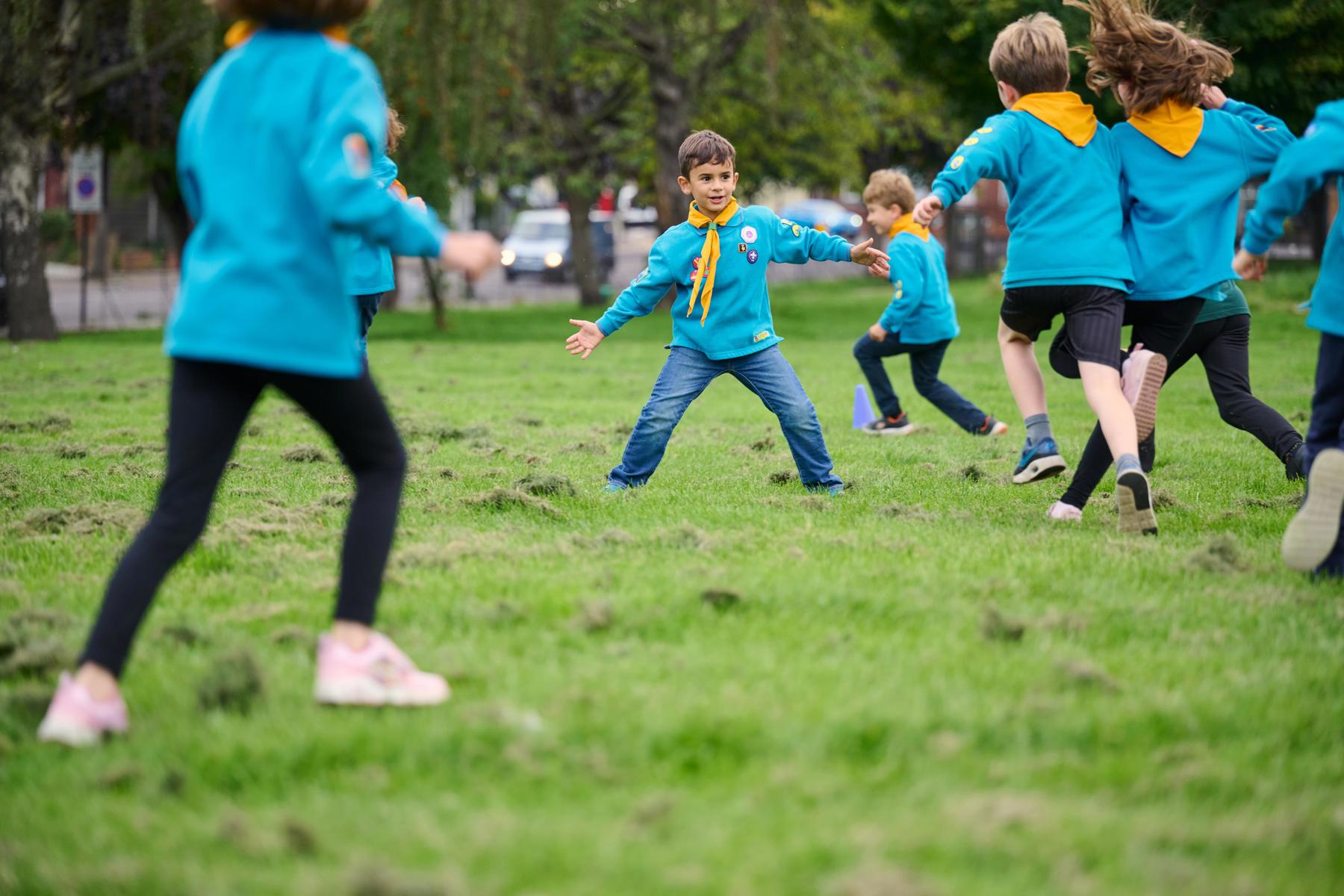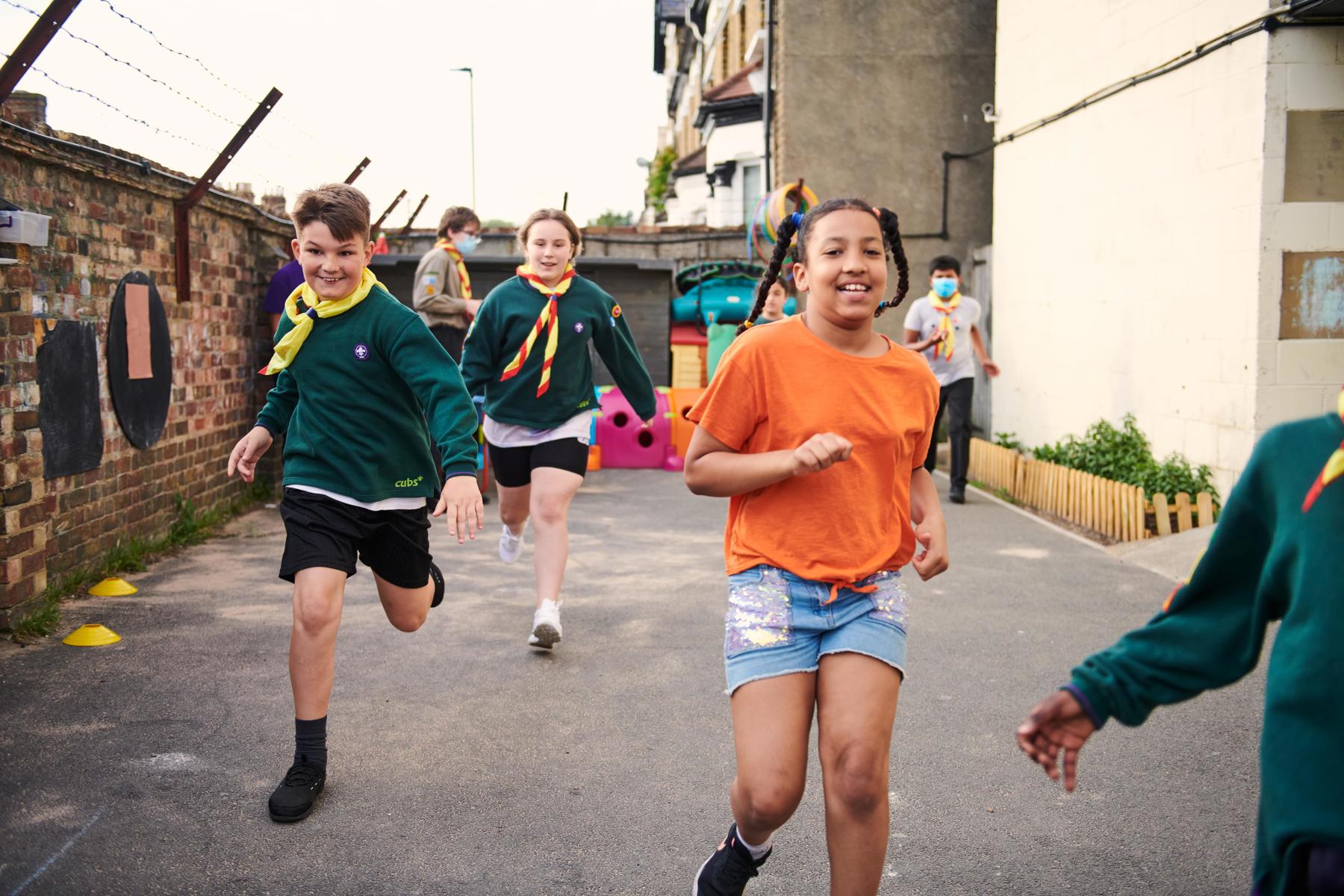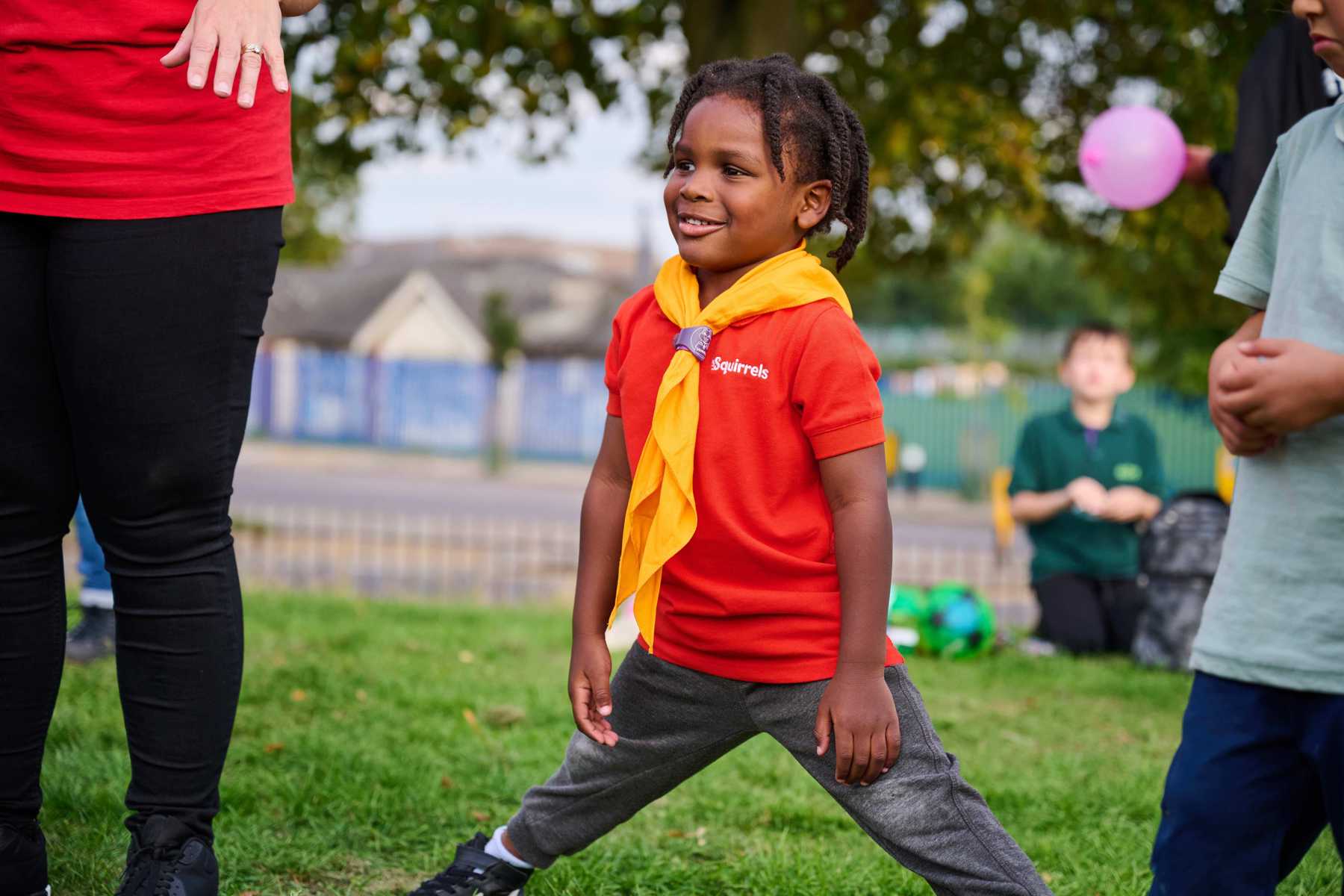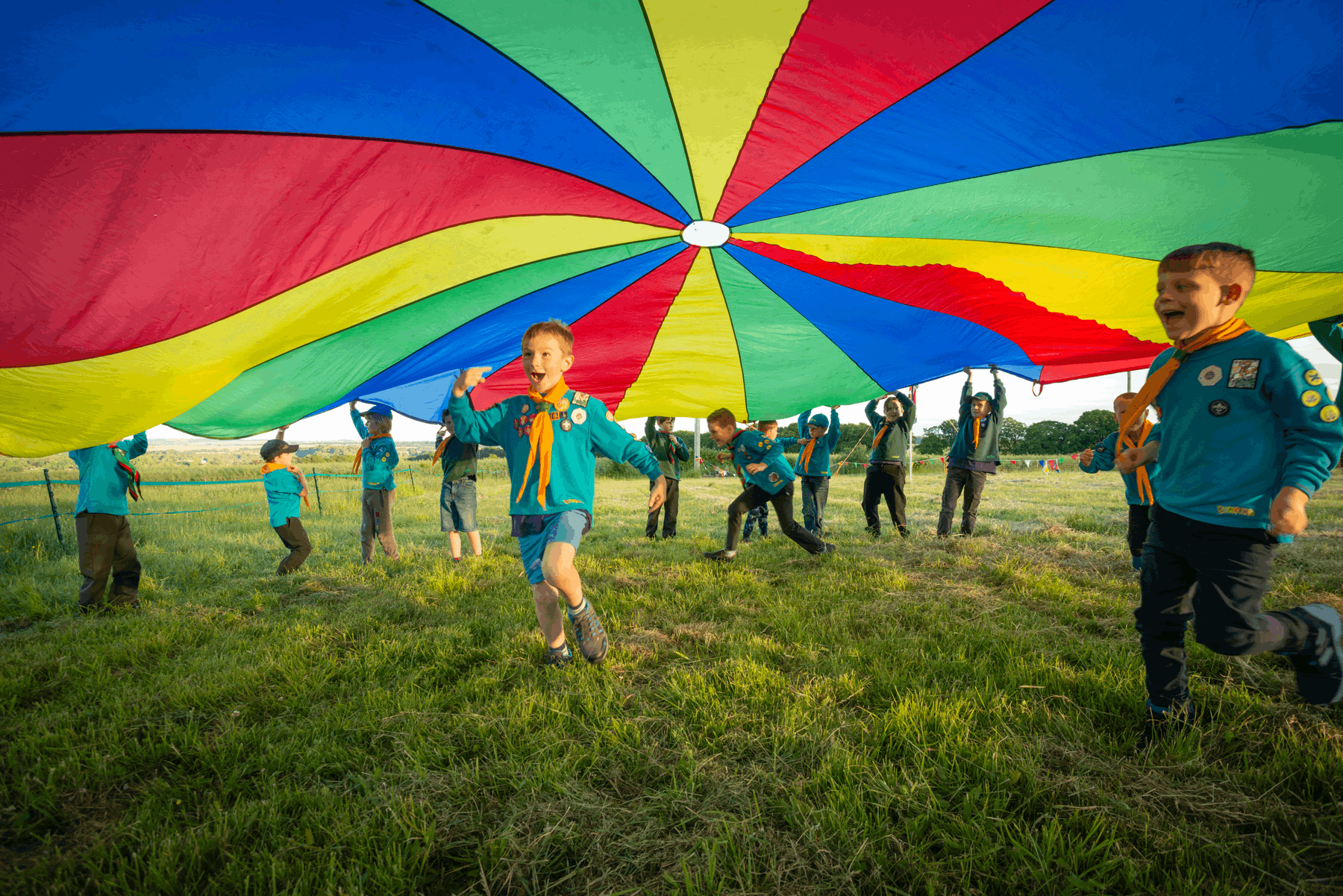Running active games safely
Incidents can occur during active games. Here's some guidance which can help you manage these activities in order to reduce risk.
What are active games?
Active games are played all the time in Scouts, including wide games. They're played both indoors and outdoors. They're an important and fun part of our Scouts programme.
This guidance is designed to provide leaders and volunteers with some suggestions of how to manage these activities, in order to reduce the potential for incidents and injuries.
Planning active games
It's important that active games are well planned and considered. A risk assessment should always be completed.
Games should be challenging, rewarding and promote positive behaviour amongst the group. There are lots of active game ideas on the Activity Finder with options that are appropriate for all sections and age groups.
You'll need to think about the size of your group, the abilities of your group, and the number of adults you'll need to supervise the game.
You can always adapt or change the level of challenge in the game if you need to.

Creating a safe playing zone
It’s a good idea to plan your playing zone, which should be clearly defined for the players. You’ll need to consider how to overcome the key hazards in your planning and risk assessment. For example:
- Collisions with objects, such as furniture, walls or fences, windows and doors
- Slips and trips on objects, such as loose matting. spillages, or natural objects (like roots)
- Young people getting lost, split up from their group or being alone in an emergency
- Environmental hazards particular to the location, such as a pond, a low wall with a drop on the other side, a main road or a very hard floor
Here are some things to think about:
Before you start, make sure the game area is safe and clear of hazards. For example, you might want to walk round and observe the area, then do a litter pick if you’re outside or avoid a wet floor if you’re inside. Look out for areas and objects to avoid, such as car parks, roads, dips in the ground, tree stumps, rabbit holes, over-hanging trees or poisonous plants.
Before you start, make sure the game area is safe and clear of hazards. It may be that the certain things can’t be avoided in the natural environment, but think about the speed the game is likely to be played at. Will the obstacles be seen?
If it’s in the dark, will the obstacles be seen? How will people see or get help if they need it?
Setting boundaries with your group in the playing area and tell them where the no-go zones are. For example, inside this could be the kitchen, stacks of chairs or the cleaning cupboard. Outside this could be any hazards you identified, such as roads, dips in the grass, steps, rocks or rivers. You could mark out the boundaries with cones.
Ensure your equipment is undamaged and suitable for use in the game.
Check the terrain and make sure the game area is free of hazards and suitable for all users, including those using mobility aids. Any unsuitable terrain could be included in the no-go zones to make the game accessible and fairer to everyone playing.
There may be some standard rules for your meeting place, such only walking on the slope, which you'll need to remind your players of.
A good idea indoors is to have a 'stop' line away from the walls, obstacles or other hazards for running up and down games. This allows space to reach the wall or other obstacles at a lower speed, reducing the potential for a broken wrist or bumps.
Allow for a cool down space as well as the game area.
If you’re playing a wide game (a game played over a large area of land), where will you put home base? Always have a memorable ‘base’ spot where at least one adult will always be present.
Make sure people have appropriate footwear and clothing on to play the game, such as trainers.
Telling everyone where adults will be around the site and what to do if anyone in their team needs help. You may want to have more adult supervision on site, too. Always follow the Yellow Card.
Think about where you will be playing the game and the individuals who will be playing it. Will you need to take turns if you have a large group?
If playing in a public space, making sure young people are paired up, so no young person is left alone. They should run, hide, play or move together. Remind everyone how they can use the space respectfully, without disturbing the wildlife or other people enjoying the site if you're in a public space.
Make sure everyone knows how to get help in an emergency. How will they find an adult or get help to them? How can they get in touch with home base?

Playing the game safely
It's important to make sure everyone knows what to do.
Think carefully about the key hazards when playing the game as part of your planning and Risk Assessment. For example:
- The numbers of players, their size and abilities, and the control of contact. All these things will need to be considered and monitored.
- Behaviour during a game can change. How will you ensure the game continues to be fun for everyone?
- How will you stop the game quickly?
- How will you supervise the game? Don’t forget the young people who are ‘out’ or having a rest will need supervising too.
Here are some things to think about:
Tell everyone how long the game will go on for.
Clearly and carefully explain what the rules are. Take time and have patience while telling everyone what to do.
Give short instructions clearly and concisely. You'll need to carefully explain these at the start of the game, each time you play it.
You could have a practice round of the game to make sure everyone knows what they’re doing.
Let young people help explain to each other what to do, too.
Having a clear way to communicate that the game must stop when needed.
This could be a long blow on a whistle. For example, ‘2 blows of the whistle means freeze’.
There may be a contact element in some games. Players will need to understand how to do this safely.
Make sure everyone understands what contact is acceptable, and monitor contact throughout the activity.
For complex games, you may wish to take a step-by-step approach before fully launching into the game. This can make sure everyone knows what to do.
Games should be supervised at all times, over the whole game zone. Make sure you’ll have enough adult helpers.
You may need some parents and carers to help if you’re short on helpers.
Always follow the Yellow Card.
Remember to monitor behaviour. You may decide to stop the game if behaviour becomes overexcited.
Carry out regular head counts, more frequently when outside and in the dark, to make sure everyone is accounted for.
It's easy not to notice getting wet, cold or overheated when playing a game. You may want to have drinks or warm jumpers ready for people, as well as a back-up plan for any changes to the weather.

Making active games accessible
Some players may need additional support or adjustments made to a game so they can comfortably join in. You can adjust equipment, space and technique in any game to suit your players.
Remember, all Scout activities should be inclusive and accessible. Find out more about making Reasonable adjustments.
Can the rules be simplified or relaxed?
Think about the accessibility of the area you are playing in. Can everyone move around the space? Do you need to make some areas out of bounds?
Any unsuitable terrain could be included in the no-go zones to make the game accessible and fairer to everyone playing.
Make sure the circle space and the surrounding terrain used are suitable for everyone in your group.
Remember to create a circle with enough space for everyone, including anyone using a mobility aid, to move around easily.
Can people move in a different way across the space? Do people have to run to play the game?
Some people may choose to walk or take on a more stationary role, such as guarding the den.
If it’s too noisy and struggles with the noise, the person leading the activity can remind everyone to be quieter.
Can you adapt the level of noise in the game? Does it need to involve noise, such as whistles or shouting?
You could provide ear defenders for the person to wear. You could allow people to take noise breaks.
If playing inside, shutting external doors and windows can help reduce noise too.
Make sure there’s a way to include everyone in this game or activity.
This might be giving them the opportunity to take on another role instead, such as timekeeping, scorekeeping, playing or stopping music, or refereeing.
People could play a game in pairs or small teams to support each other. They might run, hide, throw or catch together.
If taking this approach, apply it to everyone in the group rather than an individual.
Take time and have patience while telling everyone what to do.
Give short instructions clearly and concisely. If you need to, pause, then repeat the same instruction using the same words.
You could let young people help explain to each other what to do, too.
You could demonstrate the game or have a practice round to make sure everyone knows what they’re doing. Remember, it doesn't matter if people make mistakes.
You could have visual resources to explain the game or a printed copy of the instructions for anyone who may need them.
If anyone's colour blind, make sure to have distinct colour markers and tokens to help them to tell each one apart.
You could think about how people are tagged.
If people may struggle to tag each other, or may be uncomfortable or sensitive to touch, you could use tag-rugby velcro belts.
People then need to pull off a velcro tag to tag someone.
You could point to people or hover your hand above their head to signal they’re on, rather than tapping someone on the shoulder.
If someone isn’t comfortable in holding hands with someone else, give them the opportunity to hold a piece of material, such as a Necker or piece of rope, with the other person to connect them together.
A lot of games can be played standing up or sitting down, either on the floor or on chairs.
Make sure any actions are things everyone can do. For example, people could kick a ball rather than throw it if that’s easier for everyone to do.
Adapt games so that they’ll work for everyone in your section.
You could use bigger targets, soft balls or equipment that makes a noise.
For example, you could use a lighter ball, such as a beach ball, or use pegs rather than tying knots.
If someone needs different equipment, it may make them feel less self-conscious if everyone uses this equipment, rather than singling anyone out.
You can remove the competitive elements of the game if this would better suit the group.
You may also want to reward teamwork, listening and cooperation instead of, or as well as, winning and points.


Our Safety Checklists are aimed to help all adults working with young people to fulfil their role and responsibilities in managing and supporting safety in Scouts.

Looking for an active game? Want to try something new? Check out the range of active games on the Scouts Activity Finder.
Take a look at our 10-minute filler games
10-minute filler gamesCircle game ideas
Take a look at our idea for 15 quick and easy circle games.
Take a look at the circle gamesWide game ideas
Check out our wide game ideas